Syrians returning home face the threat of landmines.
Idlib, Syria
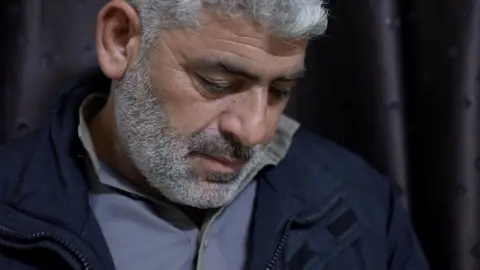 BBC
BBCAigad never thought that his dream of returning to the farm would turn into a nightmare.
He fights back tears as he shows us a photo of his late father, surrounded by smiles and abundant olive trees in their land in Syria’s northwest Idlib province.
The picture was taken five years ago, a few months before forces affiliated with the former government took over their village near the town of Saraqeb.
The city was a strategic stronghold for the Syrian opposition for years before forces allied with the ousted government of Bashar al-Assad launched an offensive against rebels in Idlib province in late 2019.
In early 2020, hundreds of thousands of residents fled their homes as Assad’s forces took control of several rebel strongholds in the northwest.
Aygad and his father were among those displaced.
“We had to leave because of the war and the airstrikes,” Aygad says as tears fill his eyes. “My father was not willing to go, he wanted to die in his country.”
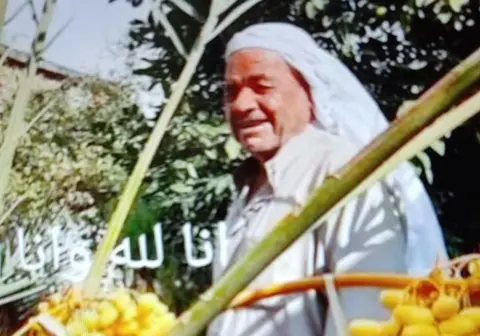
Since then, father and son have been eager to return. And in November 2024, when opposition forces took control of their village, their dream was about to come true. But soon disaster struck.
“We went to our land to collect some olives,” Aygad explained. “We went in two cars. My father took another route back to our house in Idlib. I warned him, but he told him firmly, the car was hit by a land mine and exploded.”
Aigad’s father died instantly on the spot. Not only did he lose his father that day, he also lost his family’s main source of income. Their 100,000 square meter farm is filled with 50 year old olive trees. It is now designated as a hazardous mine.
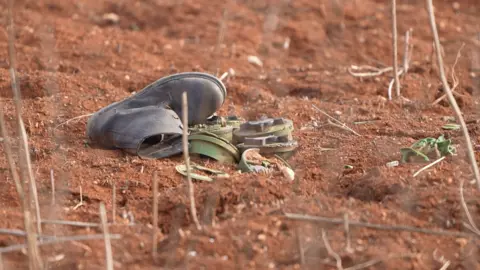
At least 144 people, including 27 children, have been killed by landmines since the fall of Bashar al-Assad’s regime in early December, according to the Halo Trust, an international organization that works to clear landmines and other explosives.
The Syrian Civil Defense – known as the White Helmets – told the BBC that many of those killed were farmers and landowners trying to return to their land after the fall of the Assad regime.
Unexploded remnants of war pose a serious threat to lives in Syria. They are mainly divided into two categories. Primarily unexploded ordnance (UXOs) such as cluster bombs, mortars, and grenades.
Hassan Talfa, who heads the White Helmets group in north-western Syria, explains that these weapons are usually seen above ground, so they are not a challenge to clean.
The White Helmets cleared 822 UXOs in northwestern Syria between November 27 and January 3.
The biggest challenge, according to Mr Talfa, is in the second category of ammunition – explosives. The former government says hundreds of thousands of troops are stationed in various parts of Syria – mainly in farmland.
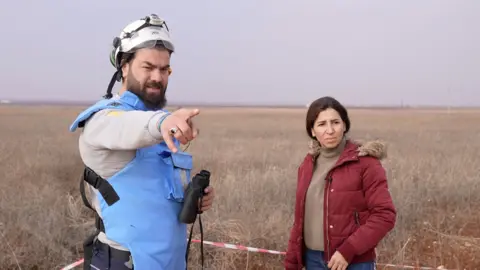
According to the White Helmets, most of the deaths recorded since the fall of the Assad regime have occurred on former battlefronts. Most of those killed were men.
Mr. Talfa took us to two huge fields surrounded by land mines. Our car followed him down a long, narrow and winding dirt road. It is the only safe way to reach the plains.
On the side of the road, children run around. Hasan told us that they are families who have recently returned. But mining hazards beset them.
As we get out of the car, he points to a block in the distance.
In Idlib province, he tells us, “It is the last point that separates the areas under the control of government forces from those occupied by the opposition.”
He added that Assad’s forces had planted thousands of explosives in the fields beyond the dam to stop rebel forces from advancing.
The fields around where we were standing were once important agricultural lands. Today, except for the green mines that we can see with binoculars, they are all barren.
With no experience in clearing mines, what the White Helmets can do now is cordon off these fields and hammer warning signs along their borders.
They also spray warning messages on garbage barriers and houses around the edge of the field. “Danger – landmines ahead,” they read.
They lead campaigns to raise awareness among local residents about the dangers of entering contaminated land.
Going back, a farmer in his 30s recently came to his country. He tells us that some of the land belongs to his family.
“We have not been able to identify any of them,” Mohammed said. “We used to grow wheat, barley, cumin and cotton. Now we can’t do anything. And unless we can cultivate these lands, we will always be in a low economic condition,” he said with obvious frustration.
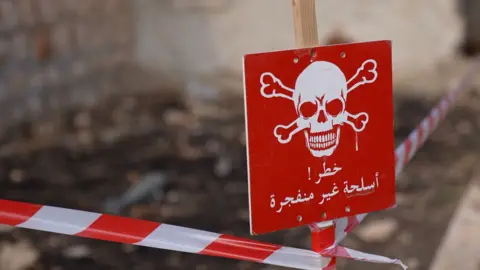
The White Helmets identified and surrounded around 117 mines within a month.
They are not the only ones working to clean up mines and UXOs, but there seems to be little coordination between the efforts of different organizations.
There are no accurate statistics for areas contaminated by UXO or landmines. But international organizations like the Halo Trust have produced rough maps.
Damian O’Brien, program manager for Halo Syria, said a comprehensive study was needed to help the country understand the extent of pollution. It estimates that around one million weapons will need to be destroyed to protect civilian lives in Syria.
“Any Syrian military position could have some explosives placed on it as a defensive measure,” Mr O’Brien said.
“There are neighborhoods in areas like Homs and Hama that are said to have been completely destroyed. Anyone who goes into those structures, either to demolish or rebuild, should be aware that there may be unexploded ordnance in there. Whether it’s bullets, cluster munitions, grenades, shells.
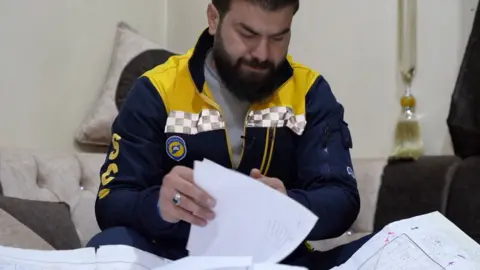 BBC news
BBC newsThe White Helmets find a treasure that can aid in the mine clearance effort. Mr. Talfah showed us maps and documents left behind by government forces in his office in Idlib city.
They show the locations, numbers and types of minerals planted in various fields in northwestern Syria.
“We will hand over these documents directly to the bodies dealing with landmines,” Mr Talfa said.
But the current knowledge of the environment in Syria does not seem to be sufficient to deal with the serious dangers that unexploded ordnance poses to civilian life.
Mr. O’Brien stressed that the international community should work with the new government in Syria to improve knowledge of the country.
“What we need from donors is financial support to expand our capacity, which means hiring more people, buying more machines and working on a larger scale.”
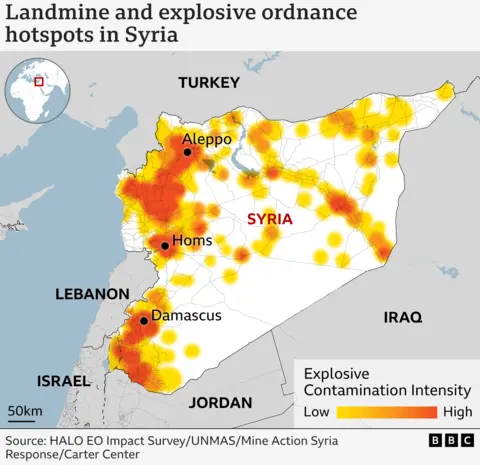
As for Mr. Talfa, cleaning up UXOs and raising awareness of their dangers has become a personal mission. Ten years ago, he lost his leg while clearing a cluster bomb.
He said the trauma and the heartbreaking incidents he witnessed of children and civilians affected by UXO fueled his determination to continue his work.
“I would never want any civilian or team member to go through what I have,” he says.
I can’t describe the feeling I feel when I clean up a disaster that threatens the lives of civilians.
However, unless international and domestic efforts are coordinated to prevent the dangers of landmines, the lives of many civilians, especially children, are at risk.


